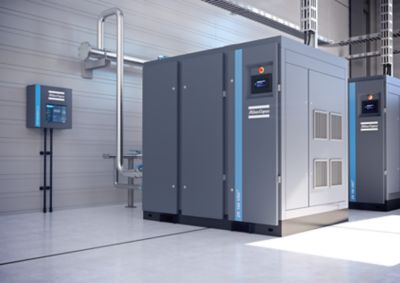In today's blog you will learn how to save compressed air and thereby reduce your running costs. Get the best possible efficiency out of your practice today by expanding your compressed air expertise with five simple tips. Lower your compressed air costs in the long term without reducing the compressed air produced!
1. Reduce compressor idling
In the case of standard compressors with full load/idle control, the compressor is designed for the maximum volume flow required. The compressor can only control two polymerization states. To put it simply: the full load/idle control only knows one or two.
The variable speed control uses a compressor whose engine speed is automatically adjusted to the air demand. This type of control is interesting when the pressure network is not constant and fluctuates between different consumption curves. Compressors with speed control vary and generate exactly the compressed air volume flow that is currently required, so that idle times can be reduced and a lot of energy can be saved.
2. Locate and eliminate air leaks in the compressed air system
15 to 60 percent of the compressed air you generate is lost through undetected leaks! Not only does the generated compressed air escape. Leaks can lead to longer running times, which has a negative impact on energy costs. For these reasons, it is important to identify leaks early in order to be able to act quickly and save money. You may be wondering how to detect leaks early.
There are different possibilities: During factory tours outside of production times, you can locate leaks acoustically. Soapy water or special sprays can be very helpful in finding leaks. It is impossible to test every application outside of production time. Ultrasonic gauges or acoustic cameras can detect leaks during production. These modern locating devices can also find smaller leaks at greater distances and record all relevant data.
3. Higher-level control for optimal interaction
Individual compressors are often only part of a larger compressor station. In order to better understand the entire compressed air system, it makes sense to use a higher-level controller. Distributing the running time over different compressors reduces the risk of failure and simplifies maintenance. In the event of an unexpected failure, the connected backup compressor can be started automatically by the controller. This prevents drops in operating pressure or production downtime. Thus, a higher level of control contributes to a trouble-free production process, reducing unplanned costs. Using the compressor evenly is very beneficial and can extend the running time of the compressor.
During factory tours outside of production times, you can locate leaks acoustically. Soapy water or special sprays can be very helpful in finding leaks. It is impossible to test every application outside of production time. Ultrasonic gauges or acoustic cameras can detect leaks during production. These modern locating devices can also find smaller leaks at greater distances and record all relevant data.
4. Use heat recovery in compressors
With the help of heat recovery, the recovered energy can be used for other purposes. There are two principles to heat recovery. Heat recovery through heated cooling air is opposed to heat recovery through hot water. In both cases, the heat obtained can be used to heat production facilities, for individual processes, or as hot water for showers in the changing rooms.
5. Select the correct compressor type and operating pressure
With regard to energy costs, the operating pressure plays an important role. This should only be as high as necessary, since higher operating pressures lead to higher power requirements and ultimately higher overall costs. If you have individual manufacturing processes in your production that require higher operating pressures, it makes sense to think about shutting off your compressed air supply . Here, additional compressors can keep the level of the compressed air network constant and at the same time represent an enormous savings potential.

